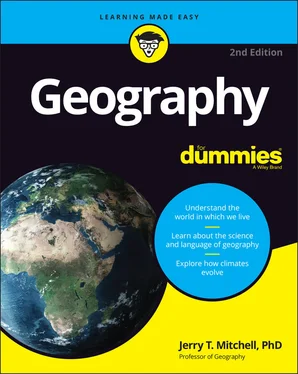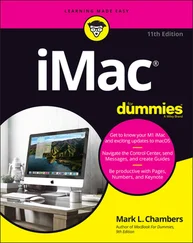Jerry T. Mitchell - Geography For Dummies
Здесь есть возможность читать онлайн «Jerry T. Mitchell - Geography For Dummies» — ознакомительный отрывок электронной книги совершенно бесплатно, а после прочтения отрывка купить полную версию. В некоторых случаях можно слушать аудио, скачать через торрент в формате fb2 и присутствует краткое содержание. Жанр: unrecognised, на английском языке. Описание произведения, (предисловие) а так же отзывы посетителей доступны на портале библиотеки ЛибКат.
- Название:Geography For Dummies
- Автор:
- Жанр:
- Год:неизвестен
- ISBN:нет данных
- Рейтинг книги:5 / 5. Голосов: 1
-
Избранное:Добавить в избранное
- Отзывы:
-
Ваша оценка:
- 100
- 1
- 2
- 3
- 4
- 5
Geography For Dummies: краткое содержание, описание и аннотация
Предлагаем к чтению аннотацию, описание, краткое содержание или предисловие (зависит от того, что написал сам автор книги «Geography For Dummies»). Если вы не нашли необходимую информацию о книге — напишите в комментариях, мы постараемся отыскать её.
Geography For Dummies
Geography For Dummies
Geography For Dummies — читать онлайн ознакомительный отрывок
Ниже представлен текст книги, разбитый по страницам. Система сохранения места последней прочитанной страницы, позволяет с удобством читать онлайн бесплатно книгу «Geography For Dummies», без необходимости каждый раз заново искать на чём Вы остановились. Поставьте закладку, и сможете в любой момент перейти на страницу, на которой закончили чтение.
Интервал:
Закладка:
There are diverse accounts of the method of measurement. Some say Eratosthenes had his assistants count camel strides (yes, camel strides) that they measured in stade , the Greek unit of measurement. In any event, he came up with a distance of 500 miles between Syene and Alexandria. That meant Earth was about [500 x 50 =] 25,000 miles around (“about” because the relationship between stade and miles is not exactly known). The actual circumference is 24,901 miles at the equator, so Eratosthenes was very close.
Interesting fact: The circumference is 41 miles less pole to pole; more on that in Chapter 4!
About a century-and-a-half later, another Greek named Posidonius calculated Earth’s circumference and due to differences in the lengths of Roman versus Greek stadia, others reported his measurement as 18,000 miles. Posidonius’ measurement became the generally accepted distance mainly thanks to Strabo, the great Roman chronicler, who simply did not believe that Earth could be as big as Eratosthenes said it was. About 18 A.D. Strabo wrote his Geography , which became the most influential treatise on the subject for more than a millennium. Geography credited the calculations of Posidonius and rejected those of Eratosthenes. And that leads to an interesting bit of speculation. Columbus was familiar with Geography , so he was aware of the official calculation of Earth’s circumference — 18,000 miles. Had he known the true circumference was 25,000 miles, like Eratosthenes said, Columbus would have known that China was thousands of miles farther to the west than Strabo suggested. And if he had known the true distance to China, would Columbus ever have set sail?
As a result, modern geographers are into all kinds of stuff. Some specialize in patterns of climate and climate change. Others investigate the distribution of diseases, or the location of health care facilities. Still others specialize in urban and regional planning, or resource conservation, or issues of social justice and equality, or patterns of crime, or optimal locations for businesses — the list goes on and on. Certainly, the ancient ge and graphe still apply, but geography is much more than it used to be.
Exposing Misconceptions: More Than Maps and Trivia
Geography is a widely misunderstood subject. Many people believe it’s only about making maps, studying maps, and memorizing locations. One reason is that polls and pundits occasionally decry the “geographic ignorance” of Americans, which usually means the average person doesn’t know where important things are located. Presumably, therefore, if you memorize the world map, then you “know geography.” Another reason is that on many TV quiz shows, contestants are occasionally asked “geography questions.” Almost always, the answer is a fact that can be understood by studying a map and/or memorizing the locations of things or events.
Knowledge of the location of things is important and useful. Everything happens somewhere; and if you know the where, then the event has meaning that it otherwise would not. So map memorization is cool, but you need to keep it in perspective. Memorizing locations is to geography what memorizing dates is to history, or what memorizing the multiplication table is to mathematics. Namely, it’s a foundation — a base — upon which you can build and develop deeper understandings.
 Have you ever asked an English professor if they know the 26 letters of the alphabet? Of course not! It’s silly. But care to guess how many times I have been asked to rattle off a list of state or country capitals? It’s equally as silly. Just as letters build words, and then words build sentences, and then those sentences become ideas to share, so too are places. For a geographer, places are like our alphabet, a starting point to explain the complexity of Earth. The bottom line is: There is more to geographic awareness than where something is. As other geographers have stated, we need to think about where, why there, and why we should care.
Have you ever asked an English professor if they know the 26 letters of the alphabet? Of course not! It’s silly. But care to guess how many times I have been asked to rattle off a list of state or country capitals? It’s equally as silly. Just as letters build words, and then words build sentences, and then those sentences become ideas to share, so too are places. For a geographer, places are like our alphabet, a starting point to explain the complexity of Earth. The bottom line is: There is more to geographic awareness than where something is. As other geographers have stated, we need to think about where, why there, and why we should care.
The Geographic Advantage
Geographers still make maps and study them, and certainly, geography still consists of subject matter that cries out to be memorized. But map memorization and descriptive studies take a back seat to analysis, explanation, and significance. Geographers have a unique lens by which they try to understand Earth, and this approach comes with several advantages.
Geographer Susan Hanson described the Geographic Advantage as a focus on the
relationships between people and the environment
importance of spatial variability
processes operating at multiple and interlocking geographic scales
integration of spatial and temporal analysis
What this means is that geographers, more than other scholars, look at how people interact with the natural world, appreciate how interactions vary from place to place and from the local to the global, and link those processes and changes over time.
 A favorite definition of mine for geography encapsulates much of this and comes from Chinese–American geographer Yi-Fu Tuan. He stated quite simply and elegantly that “Geography is the study of Earth as the home of people.” That says it all, doesn’t it? If geography is just the study of Earth, well then isn’t also geology or oceanography? If geography is just the study of the home of people, we then isn’t also anthropology? It is the combination of the two together, understanding physical and social systems jointly operating in this one space — Earth — that makes all the difference.
A favorite definition of mine for geography encapsulates much of this and comes from Chinese–American geographer Yi-Fu Tuan. He stated quite simply and elegantly that “Geography is the study of Earth as the home of people.” That says it all, doesn’t it? If geography is just the study of Earth, well then isn’t also geology or oceanography? If geography is just the study of the home of people, we then isn’t also anthropology? It is the combination of the two together, understanding physical and social systems jointly operating in this one space — Earth — that makes all the difference.
What is the capital city of Indonesia?
To highlight the difference between old, descriptive geography (what far too many studied as “geography” in school) and analytical geography, first consider this question: What is the capital city of Indonesia? Do you know? The question is classic “old geography,” and the answer is Jakarta. Right?
Why is Jakarta the capital of Indonesia?
 Now consider this question: Why is Jakarta the capital city of Indonesia? That’s right, “Why?” This question involves analysis and explanation. The capital of Indonesia could be any number of cities. Indeed, several cities have been over its history with Jakarta finally assuming the role in 1949. But there’s a catch to this question now. Indonesia has a plan in place to create a new capital city farther east in East Kalimantan on the island of Borneo. This is serious business as a country doesn’t just decide to move its capital every day. But this has been done before (just ask Brazil or Nigeria). So why are Indonesians considering moving theirs? Here are a couple of reasons:
Now consider this question: Why is Jakarta the capital city of Indonesia? That’s right, “Why?” This question involves analysis and explanation. The capital of Indonesia could be any number of cities. Indeed, several cities have been over its history with Jakarta finally assuming the role in 1949. But there’s a catch to this question now. Indonesia has a plan in place to create a new capital city farther east in East Kalimantan on the island of Borneo. This is serious business as a country doesn’t just decide to move its capital every day. But this has been done before (just ask Brazil or Nigeria). So why are Indonesians considering moving theirs? Here are a couple of reasons:
An unpleasant setting: Jakarta is densely populated, has overburdened infrastructure, is sinking due to over withdrawal of groundwater, and floods frequently. A new location would allow growth and it would be generally free from environmental hazards such as volcanoes and earthquakes.
In the middle of it all: Jakarta is on the western edge of the country. East Kalimantan is in the middle. Having the capital in the center of the country is important because Indonesia is flung across thousands of miles. A central location does more to integrate the citizenry and a central location also maximizes access to the seat of power.
Читать дальшеИнтервал:
Закладка:
Похожие книги на «Geography For Dummies»
Представляем Вашему вниманию похожие книги на «Geography For Dummies» списком для выбора. Мы отобрали схожую по названию и смыслу литературу в надежде предоставить читателям больше вариантов отыскать новые, интересные, ещё непрочитанные произведения.
Обсуждение, отзывы о книге «Geography For Dummies» и просто собственные мнения читателей. Оставьте ваши комментарии, напишите, что Вы думаете о произведении, его смысле или главных героях. Укажите что конкретно понравилось, а что нет, и почему Вы так считаете.












